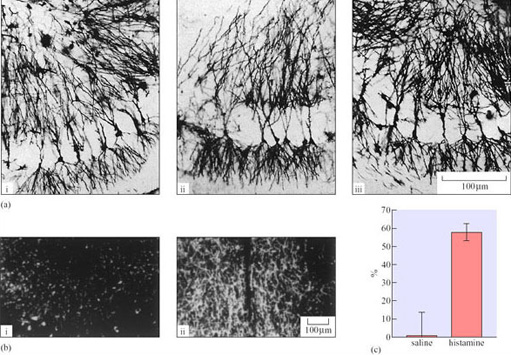6.5 The neurotransmitters histamine and serotonin: a role for chemical signalling between neurons of the hypothalamus
As in all other regions of the brain, the integration of physiological change in the hypothalamus, conducted by the dialogue between many thousands of nerve cells, is the result of transmissions across chemical synapses. The functions of the hypothalamus are therefore dependent upon neurotransmission by a number of different chemical mediators and are critically dependent on the balance between their respective activities. Monoamine neurotransmitters (histamine and serotonin) operate in subgroups of hypothalamic nerve cells (as well as neurons in other parts of the brain) and appear to be particularly important to the regulation of hibernation.
The possibility that histamine is a natural inducer of hibernation is supported by the observation that the neurotransmitter becomes detectable in complex networks of neuronal axons during hibernation, whereas it is absent or present at undetectable levels in euthermic animals (Figure 41b). The evidence for an increase in synaptic transmission by this specific neurotransmitter is seen in the light of the anatomical evidence from Figure 41a. The reduction of synaptic branching in torpor suggests that normal synapse activity is lost during torpor. The hippocampus is an area of the brain that controls arousal levels and in which histamine neurons are more prominent during hibernation. Injection of histamine into the hippocampus of ground squirrels (Spermophilus lateralis) increased the duration of hibernation bouts by over 50% (Figure 41c). Histamine is also believed to affect the response of the SCN to environmental stimuli, modifying circadian rhythm phase. Changes in phase responses to light can be increased by injecting histamine into the SCN and reduced by depleting the brain of histamine. These findings may help to explain the ability of histamine to prolong hibernation and show that histamine in different areas of the brain affects different aspects of the hibernation process.

Figure 41 (a) Reversible restructuring of dendrites that is found in the hippocampus of a ground squirrel when (i) active, (ii) torpid and (iii) on arousal. The reduction of branching, and in the number of ‘spines’ which receive incoming synapses, indicate that processing of activity at many chemical synapses is drastically reduced during torpor (Popov et al., 1992). (b) Distribution of histamine-containing nerve fibres in the hippocampus of a euthermic (i) and hibernating (ii) ground squirrel, as visualized for fluorescence microscopy with an antibody recognizing histamine (Panula, 2002). (c) Effect of the infusion of saline and histamine through a cannula into the dorsal hippocampus of each animal in a group of ground squirrels on the hibernation bout length. The bout length is expressed as a percentage of the expected remaining time in the bout at the time of the start of the infusion. Data are expressed as means ±SE (Sallmen et al., 2003).
The activity of tryptophan hydroxylase (TPH), a key enzyme in the biosynthesis of another monoamine transmitter, serotonin, undergoes marked changes in the brain during entry into hibernation, and arousal in Spermophilus erythrogenys. An increase in TPH activity was found in several regions of the brain during the pre-hibernation period in euthermic ground squirrels. A further increase in TPH activity to 150% was observed during the entry into hibernation. Significant elevation was found not only in potential TPH activity measured at the incubation temperature of 37° C but also at incubation temperature of 7° C, approximating the body temperature in hibernation. Serotonin may also contribute to the chemical induction and maintenance of hibernation.
